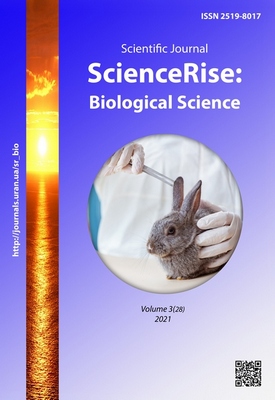Informativity of lipid metabolism indicators for diagnostics and estimation of the effectiveness of treatment of dogs with pancreatitis
DOI:
https://doi.org/10.15587/2519-8025.2021.241207Keywords:
lipid metabolism, pathogenesis, diagnostics, lipidogram, biochemical indexes, biochemical parameters, dogs, pancreatitisAbstract
The aim of the research: to substantiate the pathogenetic role of lipid metabolism disorders in the occurrence and course of pancreatitis in dogs and to establish the informativeness of its indicators for diagnosis and evaluation of treatment effectiveness based on clinical and laboratory research methods.
Materials and methods. Used clinical, instrumental, laboratory methods, including morphological studies of blood, urine, biochemical studies of serum: determination of the lipid profile by the content of triacylglycerols, total cholesterol, lipoproteins cholesterol of very low – HDL, low – LDL and high density – VLDL, traditional tests and statistical methods.
Results. It was found that the most significant changes are inherent in the metabolism of lipids and lipoproteins in the serum: significantly increased concentrations of cholesterol, triacylglycerols, LDL cholesterol and especially LDL cholesterol. The content of HDL cholesterol, on the contrary, in the acute course of pancreatitis is below normal. The content of triacylglycerols, LDL cholesterol and VLDL remains high. Total cholesterol is normalized, and the level of HDL is below normal.
Conclusions. Serum lipidogram of dogs without clinical symptoms of pathology does not differ in composition from the results obtained by other researchers. For pancreatitis in dogs, the concentration of total cholesterol increases by 1.9 times, triacylglycerols – by 5.4 times, cholesterol VLDL – in 6.0 times and LDL cholesterol – 7.7 times. The content of HDL cholesterol, in contrast, in the acute course of pancreatitis is 1.5 times lower than in clinically healthy dogs. Treatment reduces the degree of hyperenzymemia by ALT and AST, but α-amylase activity is not normalized in dogs. Above normal levels of triacylglycerols, LDL cholesterol and VLDL, and HDL cholesterol remain low, despite treatment
References
- Busel, Yu. M. (2011). Pankreatyt u sobak (patohenez, diahnostyka i likuvannia). Bila Tserkva, 20.
- Lokes, P. I., Kibkalo, D. V., Liakhovych, K. V. (2009). Diahnostychna znachymist biokhimichnykh pokaznykiv syrovatky krovi sobak za hepatorenalnoho syndromu. Visnyk Poltavskoi derzhavnoi ahrarnoi akademii, 3, 87–93.
- Kaneko, J., Harvey, J., Bruss, M. (1997). Clinical Biochemistry of Domestic Animals. Academic Press, 932. doi: http://doi.org/10.1016/b978-0-12-396305-5.x5000-3
- Boikiv, D. P., Bondarchuk, T. I., Ivankiv, O. L. et. al. (2007). Biokhimichni pokaznyky v normi i pry patolohii. Kyiv: Medytsyna, 320.
- Tymoshenko, O. P., Zemlianskyi, A. O., Vyhovska, K. L., Kuzmina, Yu. V. (2013). Pokaznyky lipidohramy syrovatky krovi sobak bez klinichnykh oznak patolohii. Naukovyi visnyk Luhanskoho natsionalnoho ahrarnoho universytetu, 49, 136–140.
- Xenoulis, P. G., Steiner, J. M. (2010). Lipid metabolism and hyperlipidemia in dogs. The Veterinary Journal, 183 (1), 12–21. doi: http://doi.org/10.1016/j.tvjl.2008.10.011
- Kirk, R., Bonagura, Dzh. D. (2005). Sovremennii kurs terapii Kirka. Moscow: Akvarium print, 1376.
- Salupere, V. (1988). Klinicheskaia gastroenterologiia. Tallin: Valgus, 288.
- Horalskyi, L. P., Tymoshenko, O. P., Borysevych, B. V. et. al.; Horalskyi, L. P. (Ed.) (2013). Pankreatyt sobak. Zhytomyr: «Polissia», 216.
- Nimand, Kh. G., Suter, P. F. (2004). Bolezni sobak. Moscow: Akvarium-print, 816.
- Vasilevich, F. I., Golubeva, V. A., Danilov, E. P. et. al. (2001). Bolezni sobak. Moscow: Kolos, 472.
- Batchelor, D. J., Noble, P.-J. M., Taylor, R. H., Cripps, P. J., German, A. J. (2007). Prognostic Factors in Canine Exocrine Pancreatic Insufficiency: Prolonged Survival is Likely if Clinical Remission is Achieved. Journal of Veterinary Internal Medicine, 21 (1), 54–60. doi: http://doi.org/10.1111/j.1939-1676.2007.tb02928.x
- Hallay, J., Kovacs, G., Szarmari, K. et. al. (2001). Early jejunal nutrition and changes in the immunological parameters of patients with acute pancreatitis. Hepatogastroenterology, 48 (41), 1488–1492.
- Sympson, D., Uéls, R. (2003). Bolezny pyshchevarytelnoy systemy sobak i koshek. Moscow: Akvaryum-LTD, 496.
- Shalimov, O. O., Hrubnyk, V. V., Horovits, Dzh. (2000). Khronichnyi pankreatyt. Suchasni kontseptsii patohenezu, diahnostyky i likuvannia. Kyiv: Zdorovia, 256.
- Rebrova, O. Iu. (2002). Statisticheskii analiz meditsinskikh dannykh. Primenenie paketa prikladnykh programm STATISTIKA. Moscow: Medi Sfera, 312.
- Zemlianskyi, A. A., Lokes-Krupka, T. P., Kuzmina, Iu. V. (2014). Pokazateli lipidogrammy syvorotki krovi sobak i koshek bez klinicheskikh priznakov patologi. Mezhdunarodnii vestnik veterinari, 1, 52–56.
- Osorio, J. H. (2009). The variability in the canine lipid profile values and its possible relationship with the measurement method used. Vet. zootec., 3 (1), 70–77.
- Vlizlo, V. V., Fedoruk, R. S., Ratych, I. B. et. al.; Vlizlo, V. V. (Ed.) (2012). Laboratorni metody doslidzhen u biolohii, tvarynnytstvi ta veterynarnii medytsyni. Lviv: SPOLOM, 764.
- Levchenko, V. I., Holovakha, V. I., Kondrakhin, I. P. et. al.; Levchenko, V. I. (Ed.) (2010). Metody laboratornoi klinichnoi diahnostyky khvorob tvaryn. Kyiv: Ahrarna osvita, 437.
Downloads
Published
How to Cite
Issue
Section
License
Copyright (c) 2021 Andrii Zemlianskyi, Olga Tymoshenko, Andriy Zakhariev, Yevheniia Vashchyk, Nataliia Seliukova, Roman Dotsenko

This work is licensed under a Creative Commons Attribution 4.0 International License.
Our journal abides by the Creative Commons CC BY copyright rights and permissions for open access journals.
Authors, who are published in this journal, agree to the following conditions:
1. The authors reserve the right to authorship of the work and pass the first publication right of this work to the journal under the terms of a Creative Commons CC BY, which allows others to freely distribute the published research with the obligatory reference to the authors of the original work and the first publication of the work in this journal.
2. The authors have the right to conclude separate supplement agreements that relate to non-exclusive work distribution in the form in which it has been published by the journal (for example, to upload the work to the online storage of the journal or publish it as part of a monograph), provided that the reference to the first publication of the work in this journal is included.









